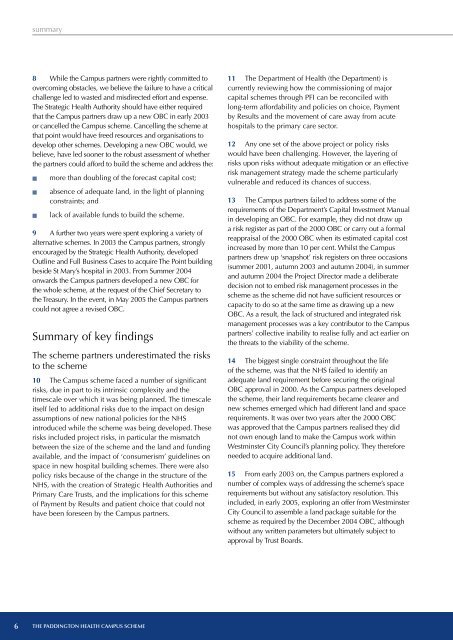Department of Health: The Paddington Health Campus Scheme
Department of Health: The Paddington Health Campus Scheme
Department of Health: The Paddington Health Campus Scheme
Create successful ePaper yourself
Turn your PDF publications into a flip-book with our unique Google optimized e-Paper software.
summary8 While the <strong>Campus</strong> partners were rightly committed toovercoming obstacles, we believe the failure to have a criticalchallenge led to wasted and misdirected effort and expense.<strong>The</strong> Strategic <strong>Health</strong> Authority should have either requiredthat the <strong>Campus</strong> partners draw up a new OBC in early 2003or cancelled the <strong>Campus</strong> scheme. Cancelling the scheme atthat point would have freed resources and organisations todevelop other schemes. Developing a new OBC would, webelieve, have led sooner to the robust assessment <strong>of</strong> whetherthe partners could afford to build the scheme and address the:nnnmore than doubling <strong>of</strong> the forecast capital cost;absence <strong>of</strong> adequate land, in the light <strong>of</strong> planningconstraints; andlack <strong>of</strong> available funds to build the scheme.9 A further two years were spent exploring a variety <strong>of</strong>alternative schemes. In 2003 the <strong>Campus</strong> partners, stronglyencouraged by the Strategic <strong>Health</strong> Authority, developedOutline and Full Business Cases to acquire <strong>The</strong> Point buildingbeside St Mary’s hospital in 2003. From Summer 2004onwards the <strong>Campus</strong> partners developed a new OBC forthe whole scheme, at the request <strong>of</strong> the Chief Secretary tothe Treasury. In the event, in May 2005 the <strong>Campus</strong> partnerscould not agree a revised OBC.Summary <strong>of</strong> key findings<strong>The</strong> scheme partners underestimated the risksto the scheme10 <strong>The</strong> <strong>Campus</strong> scheme faced a number <strong>of</strong> significantrisks, due in part to its intrinsic complexity and thetimescale over which it was being planned. <strong>The</strong> timescaleitself led to additional risks due to the impact on designassumptions <strong>of</strong> new national policies for the NHSintroduced while the scheme was being developed. <strong>The</strong>serisks included project risks, in particular the mismatchbetween the size <strong>of</strong> the scheme and the land and fundingavailable, and the impact <strong>of</strong> ‘consumerism’ guidelines onspace in new hospital building schemes. <strong>The</strong>re were alsopolicy risks because <strong>of</strong> the change in the structure <strong>of</strong> theNHS, with the creation <strong>of</strong> Strategic <strong>Health</strong> Authorities andPrimary Care Trusts, and the implications for this scheme<strong>of</strong> Payment by Results and patient choice that could nothave been foreseen by the <strong>Campus</strong> partners.11 <strong>The</strong> <strong>Department</strong> <strong>of</strong> <strong>Health</strong> (the <strong>Department</strong>) iscurrently reviewing how the commissioning <strong>of</strong> majorcapital schemes through PFI can be reconciled withlong-term affordability and policies on choice, Paymentby Results and the movement <strong>of</strong> care away from acutehospitals to the primary care sector.12 Any one set <strong>of</strong> the above project or policy riskswould have been challenging. However, the layering <strong>of</strong>risks upon risks without adequate mitigation or an effectiverisk management strategy made the scheme particularlyvulnerable and reduced its chances <strong>of</strong> success.13 <strong>The</strong> <strong>Campus</strong> partners failed to address some <strong>of</strong> therequirements <strong>of</strong> the <strong>Department</strong>’s Capital Investment Manualin developing an OBC. For example, they did not draw upa risk register as part <strong>of</strong> the 2000 OBC or carry out a formalreappraisal <strong>of</strong> the 2000 OBC when its estimated capital costincreased by more than 10 per cent. Whilst the <strong>Campus</strong>partners drew up ‘snapshot’ risk registers on three occasions(summer 2001, autumn 2003 and autumn 2004), in summerand autumn 2004 the Project Director made a deliberatedecision not to embed risk management processes in thescheme as the scheme did not have sufficient resources orcapacity to do so at the same time as drawing up a newOBC. As a result, the lack <strong>of</strong> structured and integrated riskmanagement processes was a key contributor to the <strong>Campus</strong>partners’ collective inability to realise fully and act earlier onthe threats to the viability <strong>of</strong> the scheme.14 <strong>The</strong> biggest single constraint throughout the life<strong>of</strong> the scheme, was that the NHS failed to identify anadequate land requirement before securing the originalOBC approval in 2000. As the <strong>Campus</strong> partners developedthe scheme, their land requirements became clearer andnew schemes emerged which had different land and spacerequirements. It was over two years after the 2000 OBCwas approved that the <strong>Campus</strong> partners realised they didnot own enough land to make the <strong>Campus</strong> work withinWestminster City Council’s planning policy. <strong>The</strong>y thereforeneeded to acquire additional land.15 From early 2003 on, the <strong>Campus</strong> partners explored anumber <strong>of</strong> complex ways <strong>of</strong> addressing the scheme’s spacerequirements but without any satisfactory resolution. Thisincluded, in early 2005, exploring an <strong>of</strong>fer from WestminsterCity Council to assemble a land package suitable for thescheme as required by the December 2004 OBC, althoughwithout any written parameters but ultimately subject toapproval by Trust Boards.<strong>The</strong> <strong>Paddington</strong> <strong>Health</strong> <strong>Campus</strong> scheme
















